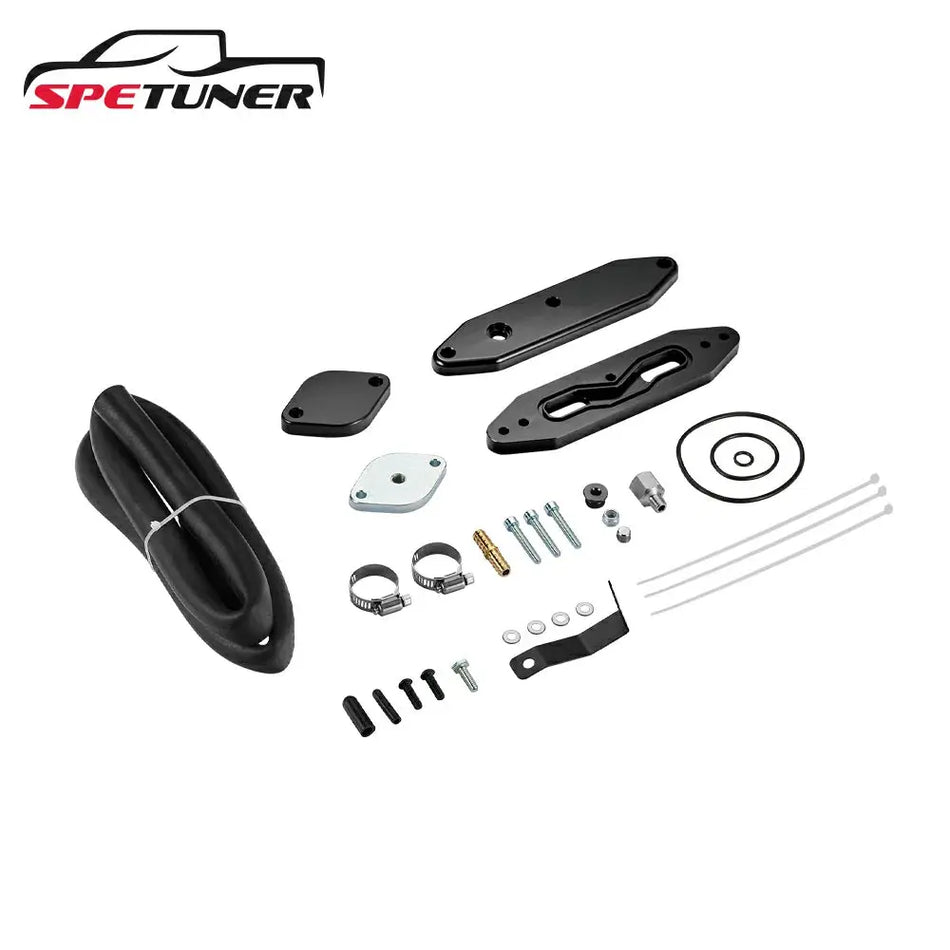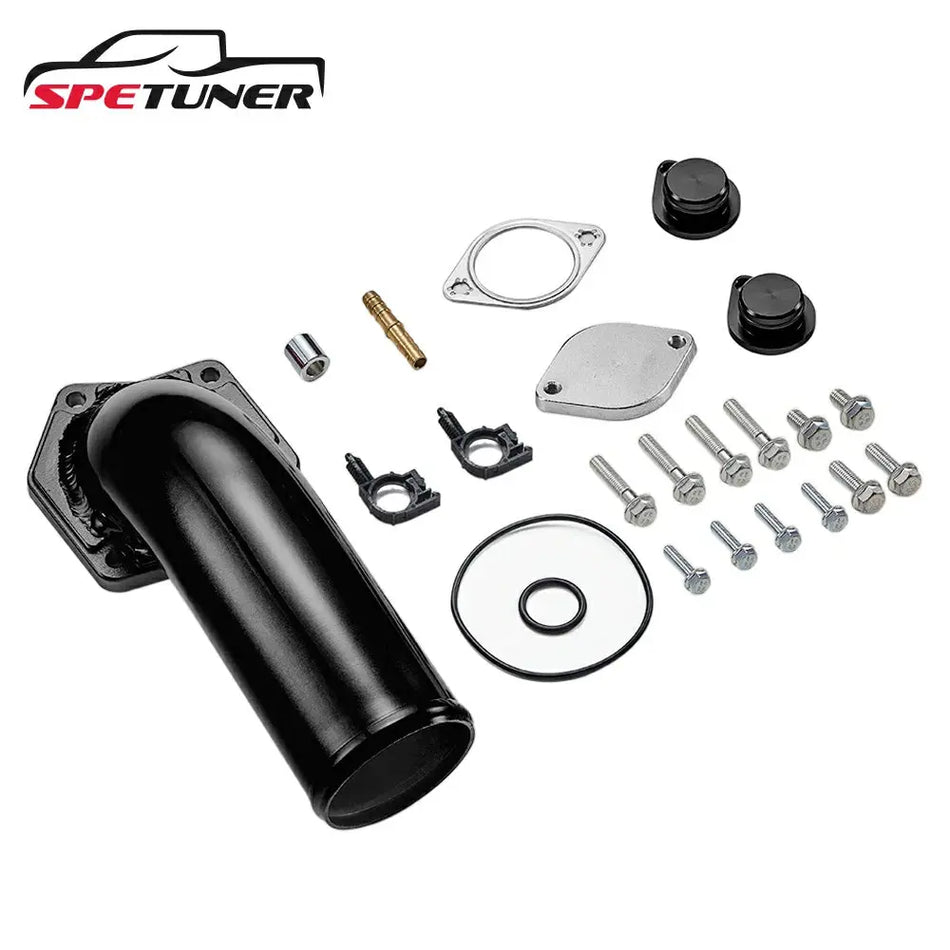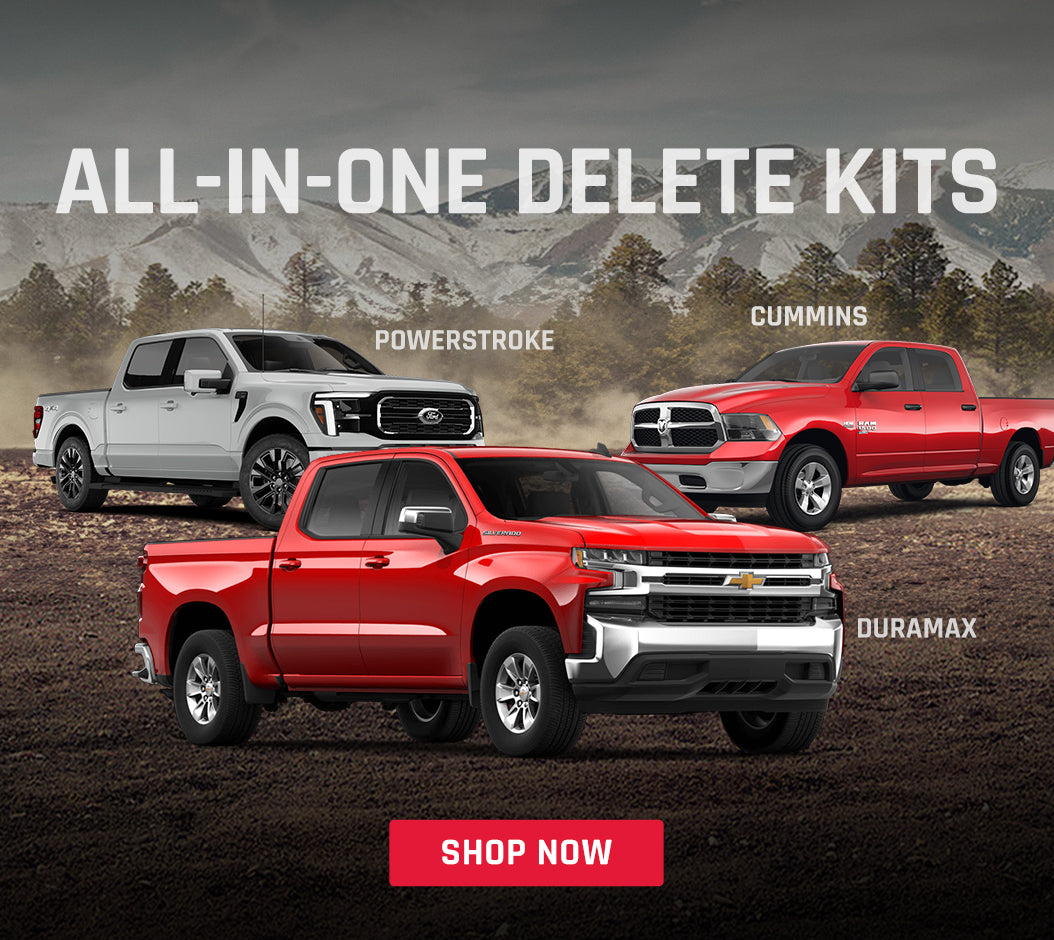Introduction: Why Are So Many 6.4 Powerstroke Owners Talking About DPF Deletes and MPG Gains?
The 6.4L Powerstroke is a beast when it comes to raw towing power and torque. But let’s be honest—when it comes to fuel economy, it’s not exactly winning awards.
Many owners report stock MPG numbers as low as 10–12 MPG, especially when city driving or towing. That’s where the idea of deleting the DPF (Diesel Particulate Filter) comes in. Removing the DPF is said to reduce backpressure, improve combustion efficiency, and ultimately boost MPG. But does it actually work?
This article dives deep into real-world numbers, tuning strategies, potential risks, and side-by-side comparisons with other diesel platforms like the 6.7L Powerstroke. Whether you’ve already deleted your DPF or are still on the fence, this guide is built to help you make the right call—with facts, not just forum hearsay.
Let’s break it down.
Real-World MPG Gains: How Much Does a 6.4 Powerstroke Improve After a DPF Delete?

Actual User Data: Before vs. After DPF Delete
If you browse forums like Powerstroke.org or Reddit, you'll see a consistent pattern: owners who delete the DPF and run a proper tune report an average gain of 2 to 4 MPG.
Before DPF delete: Most stock 6.4L Powerstrokes sit around 10–12 MPG in mixed driving.
After DPF delete + tuning: Numbers typically climb to 14–16 MPG, with some hitting 18+ on the highway under ideal conditions.
For example, one user on Powerstroke.org noted:
"I went from 11 city / 13 highway to 14 city and 17.8 highway after delete and tune. Best mod I ever did."
This kind of feedback isn't rare—it’s the norm when deletes are done right.
Visual Breakdown: MPG Shift At a Glance
|
Driving Condition |
Stock MPG |
After DPF Delete + Tune |
|
City Driving |
10–11 |
13–14 |
|
Highway Driving |
12–13 |
16–18 |
|
Towing Moderate Load |
9–10 |
11–13 |
While every truck’s result varies slightly depending on setup and driver habits, the trend is clear: removing the DPF improves efficiency when combined with a well-calibrated tune.
Why MPG Gains Vary: The 4 Key Factors
1. Tuning Quality
A delete without tuning does almost nothing. In fact, it might even hurt MPG. Most gains come from proper ECM recalibration.
2. Driving Style
Aggressive throttle kills efficiency—even after deleting. The gains are best if you drive smooth and steady.
3. Tire Size & Lift Kits
Bigger tires or 6" lifts throw off gearing and aerodynamics. That’s extra strain, and it eats into your gains.
4. Load & Tow Use
Heavy loads always reduce fuel economy. But even with trailers, a deleted truck can see improvements compared to stock.
So, to sum it up: yes, DPF delete + proper tuning = better MPG. But it’s not magic—you still need the right setup and realistic expectations.
Why Does Deleting the DPF Improve MPG on the 6.4 Powerstroke?

Understanding the DPF System
The Diesel Particulate Filter (DPF) is part of your truck’s emissions system. Its job is to trap and burn off soot particles from the exhaust, which sounds great for the environment, but not so great for performance.
To stay clean, the DPF goes through a process called “regeneration.”
This involves dumping extra fuel into the exhaust to burn off the soot—yes, raw diesel burned in the pipe, not to move the truck.
That process lowers fuel economy and increases exhaust temps. It also restricts exhaust flow, which means your engine is always pushing against backpressure.
So What Happens When You Remove It?
Once the DPF is removed and the ECM is reprogrammed, three things happen:
1. No More Regens
You stop wasting fuel on soot burn-off. That’s an instant MPG boost.
2. Improved Exhaust Flow
The turbo spools quicker, the engine breathes easier, and backpressure drops. That means more efficiency.
3. Cleaner Combustion Mapping
With tuning, you get a more refined air/fuel mix. The engine doesn’t run rich just to keep emissions happy—it runs smart.
Important: It's Not Just About Cutting the Filter
Some people delete the DPF and skip tuning. That’s a mistake.
Without tuning, the truck doesn’t know the DPF is gone. It still dumps fuel for regens. The result? Poor mileage, check engine lights, or even drivability issues.
Bottom line:
Deleting the DPF only helps MPG when paired with a smart, emissions-aware tune. The filter's physical removal matters—but the computer's brain matters more.
How to Properly Delete the DPF and Maximize Fuel Efficiency

Recommended Parts: What You Actually Need
If you want solid results and reliability, it’s not just about yanking out the filter. Here’s what most 6.4L Powerstroke owners use to do it right:
DPF/CAT Delete Pipe: This replaces the factory exhaust section. Look for stainless steel kits for better durability and fitment.
Tuner (ECM Programmer): Critical. This tells your truck the DPF is gone and recalibrates fueling, timing, and regen logic. Popular options:
SCT X4 with custom tunes
EZ LYNK AutoAgent
H&S Mini Maxx (for off-road use only)
Optional but helpful:
Cold Air Intake (CAI): Better airflow complements exhaust mods
EGT probe: Keep an eye on exhaust temps, especially with towing
Without tuning, deleting the pipe alone won’t help. In fact, it may cause more issues than benefits.
Tuning Strategies: Go Beyond Just “More Power”
You don’t have to run a hot tune to gain MPG. In fact, the best fuel economy usually comes from moderate, clean-burning tunes focused on torque at low to mid RPM.
Some tips:
Use “Tow” or “Eco” tuning modes—not “Performance” if your goal is MPG
Limit idle time. Idle tuning helps here too
Shift timing adjustments can make a big MPG difference—especially at highway speeds
Good tuners will offer custom files designed around your goals (e.g., mileage vs towing). Always ask before buying a generic setup.
The Process: What the Delete and Tune Job Actually Involves
Here’s a simplified overview of what the install typically looks like:
Remove the DPF section from the exhaust
Disconnect sensors
Unbolt or cut (depending on kit)
Install the delete pipe
Make sure all flanges are tight and aligned
Secure hangers and inspect for leaks
Plug in the tuner and flash the ECM
Load the DPF delete-enabled tune
Some kits auto-disable trouble codes (DTCs), others need manual setup
Check gauges, test drive, monitor exhaust temps
Make sure no lights pop up, and that the truck shifts smooth
For most DIYers, this is a weekend project with basic tools. If you’re unsure, any diesel performance shop can knock it out in a few hours.
Pro Tip: Always keep your stock parts. If you ever need to revert for resale or inspection, you’ll be glad you saved them.
The Risks You Need to Know Before Deleting Your DPF
Legal and Compliance Issues
Let’s be clear: DPF delete kits are not legal for on-road use in the U.S. or Canada under federal EPA regulations. They're marketed as “off-road use only” or “racing application.” Running a deleted truck on public roads can result in fines, emissions test failures, or registration issues—especially in states like California.
Some shops won’t even touch a deleted truck anymore. And dealerships? Forget about warranty coverage if they see any tampering.
Mechanical and Long-Term Engine Risks
Deleting the DPF reduces restriction, but it also removes a system designed to control exhaust temperature and soot behavior. Here are a few issues that can creep up if you don't set things up properly:
Higher EGTs (Exhaust Gas Temps): Without the DPF housing acting as a buffer, temps may rise faster—especially under load or towing.
Increased turbo wear: Spooling improves, but tuning too aggressively without proper fueling control can reduce turbo lifespan.
Oil contamination: A poorly tuned delete setup can lead to excess soot or fuel in the oil, affecting longevity.
That’s why a quality tune and EGT monitoring are non-negotiable. Done right, a delete system can run clean and safe. Done sloppy, and you could be rebuilding a motor sooner than you'd like.
Warranty, Resale, and Inspection Risks
No more powertrain warranty from Ford (if you had any left).
Resale value drops for buyers who don’t want a deleted truck—or increases only if you’re selling to the performance crowd.
State inspections could be a deal-breaker. In many regions, visual and OBD checks can flag deleted systems—even with no engine light on.
Bottom line? Deleting is a calculated tradeoff.
Yes, you’ll gain MPG and responsiveness. But you need to be fully aware of what you’re giving up—and how to stay ahead of it.
6.4L vs 6.7L Powerstroke: How Do MPG Gains Compare After DPF Delete?
Side-by-Side Fuel Economy Comparison
Both the 6.4L and 6.7L Powerstroke engines benefit from a DPF delete—but the scale of improvement and baseline fuel economy differ. Here's a quick breakdown:
|
Model |
Stock MPG (avg) |
After DPF Delete + Tune |
Typical Gain |
|
6.4L Powerstroke |
10–12 MPG |
14–18 MPG |
+2 to +6 MPG |
|
6.7L Powerstroke |
12–14 MPG |
15–20 MPG |
+3 to +6+ MPG |
The 6.7L generally sees slightly higher MPG both before and after delete. That’s due to a more refined fuel injection system, better turbo efficiency, and tighter emissions control even in stock form.
Why the 6.7L Performs Better on MPG
1. Single Sequential Turbo Setup
The 6.7’s newer turbo platform delivers smoother boost control and better efficiency, especially at low RPM.
2. Updated Fuel Injection and Mapping
Ford refined the injection timing and pressure to reduce waste and improve burn quality. Even before tuning, it runs cleaner.
3. More Efficient Regeneration System (Stock)
The 6.7 doesn't require as frequent or aggressive regens as the 6.4, so even with the DPF installed, it burns less fuel per mile.
Should You Trade Up?
Not necessarily. If you already own a 6.4L, doing a DPF delete + proper tune can bring you surprisingly close to the 6.7’s efficiency zone—especially on the highway. But if you're considering a long-term tow rig or want the best out-of-the-box fuel economy with fewer legal headaches, the 6.7L is worth a look.
That said, the 6.4L has massive potential with the right setup—and a deep torque curve that many diesel fans still love.
FAQ: Straight Answers to Common Questions About 6.4 Powerstroke DPF Deletes and MPG
Does deleting the DPF really improve fuel economy?
Yes—when paired with proper tuning. Removing the DPF eliminates regeneration cycles and reduces backpressure, both of which help fuel efficiency. Most owners see a 2–4 MPG gain, sometimes more on the highway.
Why didn’t my MPG improve after I deleted the DPF?
Chances are, you didn’t tune the truck properly—or you’re running too hot of a tune. Other possibilities:
Oversized tires throwing off your speedo/MPG calc
Aggressive throttle habits
Bad sensors or improper install causing the truck to run rich
A delete alone without tuning does nothing for MPG—in fact, it can make things worse.
Can I get better MPG without deleting my DPF?
It’s tough, but possible. You can:
Install a cold air intake and upgraded exhaust (legal options)
Use economy tuning from a reputable brand
Reduce idling, upgrade tires for less rolling resistance
Keep the EGR clean and sensors in top shape
However, none of these will match the MPG gains of a full delete setup.
Does deleting the DPF hurt my engine in the long run?
Not if it’s done right. The real risk comes from bad tuning or ignoring exhaust temps. With proper EGT monitoring, conservative tuning, and regular maintenance, many deleted 6.4s run strong for 200K+ miles.
Is a DPF delete legal?
No—on-road use of a deleted truck is illegal under federal law in the U.S.
DPF delete kits are intended for off-road or race use only. Always check local regulations and be aware of inspection requirements in your state or province.
Conclusion: Is a DPF Delete Worth It for the 6.4L Powerstroke?
If fuel economy and engine responsiveness are your goals, then yes—a DPF delete, when done correctly, can absolutely deliver real results.
Most 6.4 Powerstroke owners see noticeable improvements:
2 to 4 MPG gains are common
The truck runs cooler, shifts smoother, and breathes easier
Towing gets more efficient, and throttle response feels crisper
But it’s not without tradeoffs.
You give up:
Emissions compliance
Factory warranty
The ability to pass inspections in many states
So it really comes down to your use case. If you run your truck on private property, for towing, or in off-road applications—and you’re okay with the legal implications—a DPF delete + quality tuning can make your 6.4 feel like a new machine.
SPETUNER Recommendations
At SPETUNER, we’ve helped hundreds of diesel truck owners set up their builds the right way. If you're considering a DPF delete:
We recommend custom tunes tailored to your driving habits (not generic box files)
Use EGT monitoring and air upgrades to keep the truck safe and responsive
And always follow local regulations—we’re here to guide you on both performance and compliance
Looking to build a more efficient 6.4L Powerstroke?
Let’s talk. We offer consultation, delete kit bundles, and tuning services designed to help you unlock every MPG safely.
Recommended Reading: Want to See How the 6.7L Powerstroke Performs After a DPF Delete?
If you’re curious how the newer 6.7L Powerstroke stacks up in terms of MPG and performance after a DPF delete, check out this in-depth breakdown:
6.7 Powerstroke MPG After DPF Delete – Boost Efficiency and Performance











